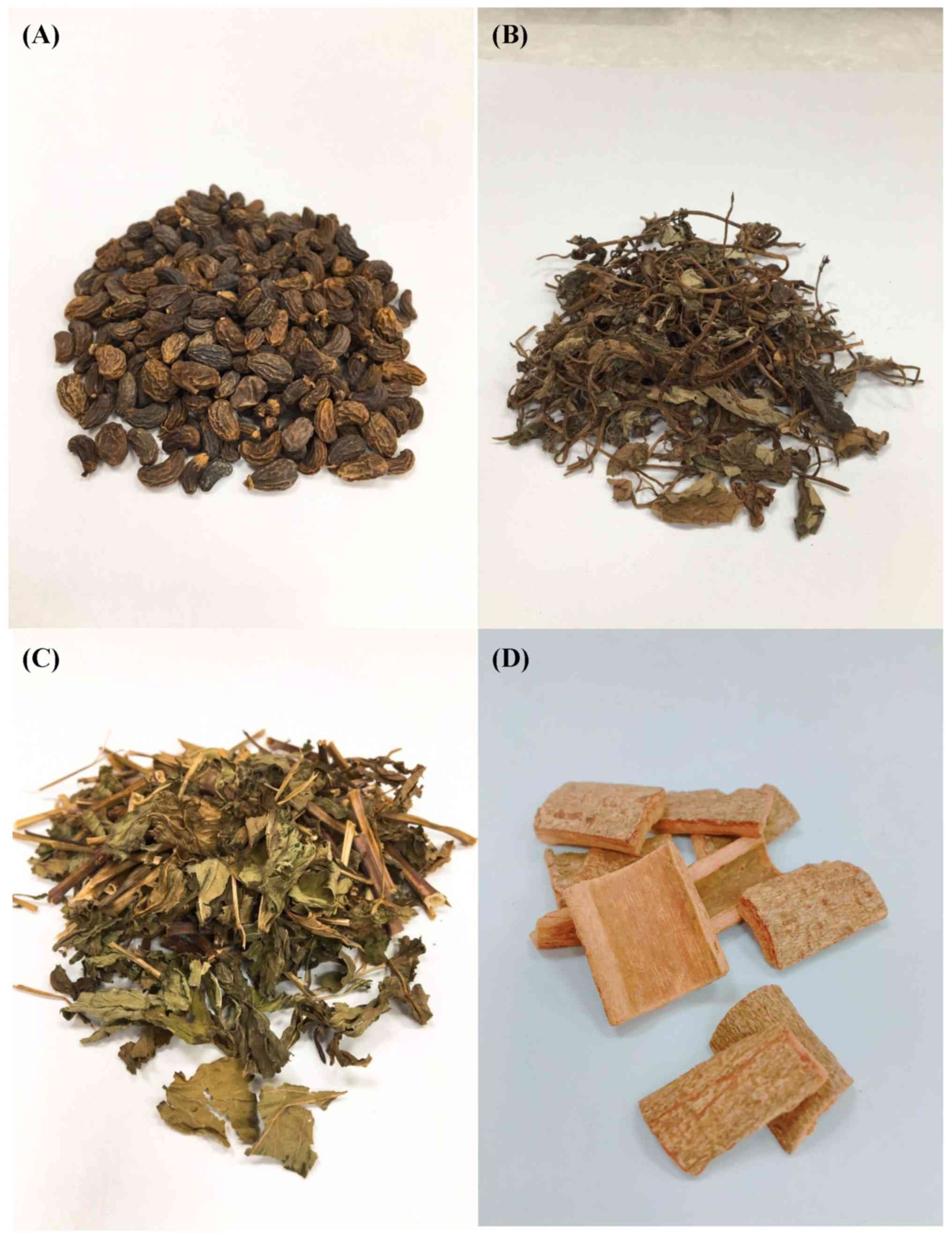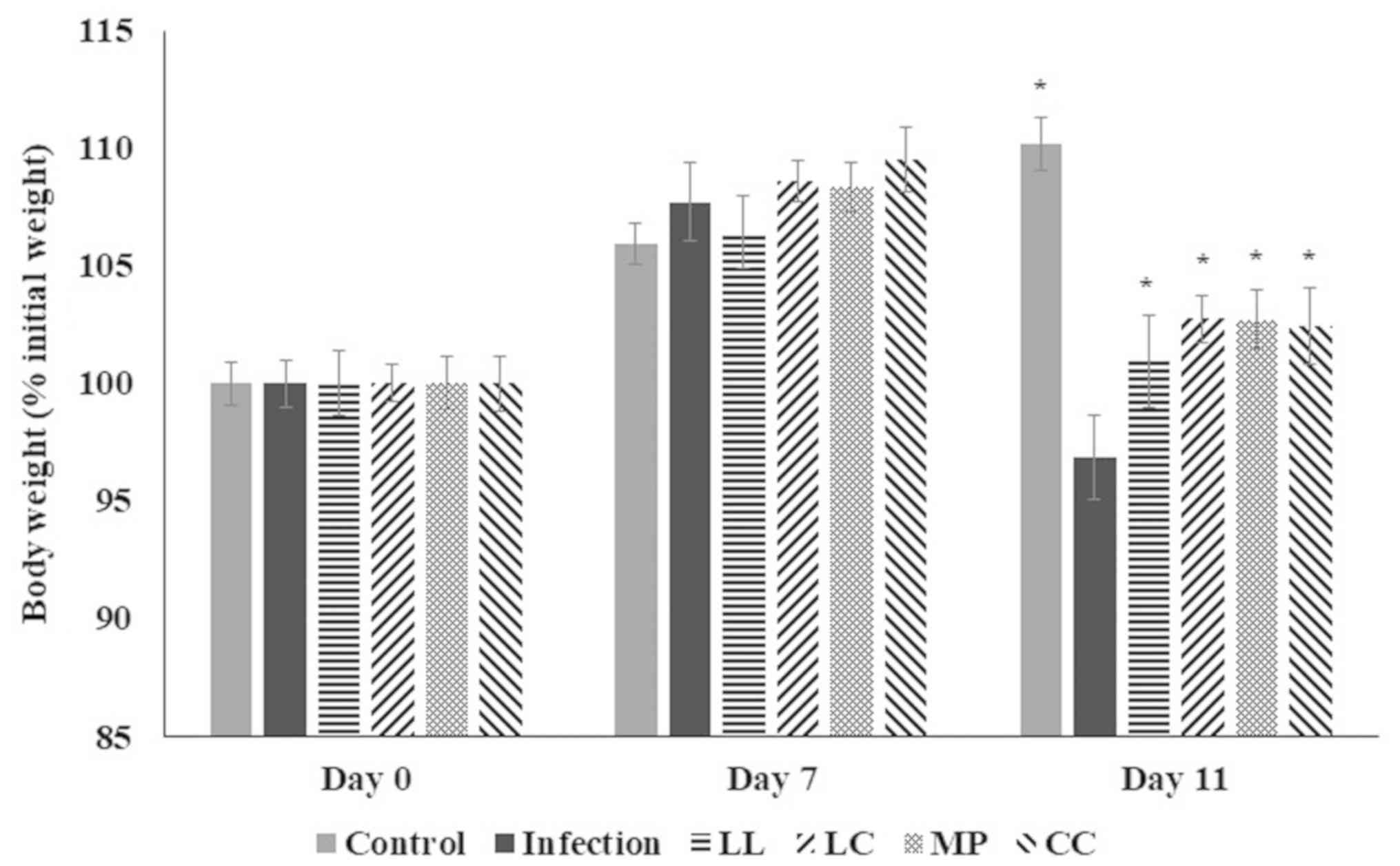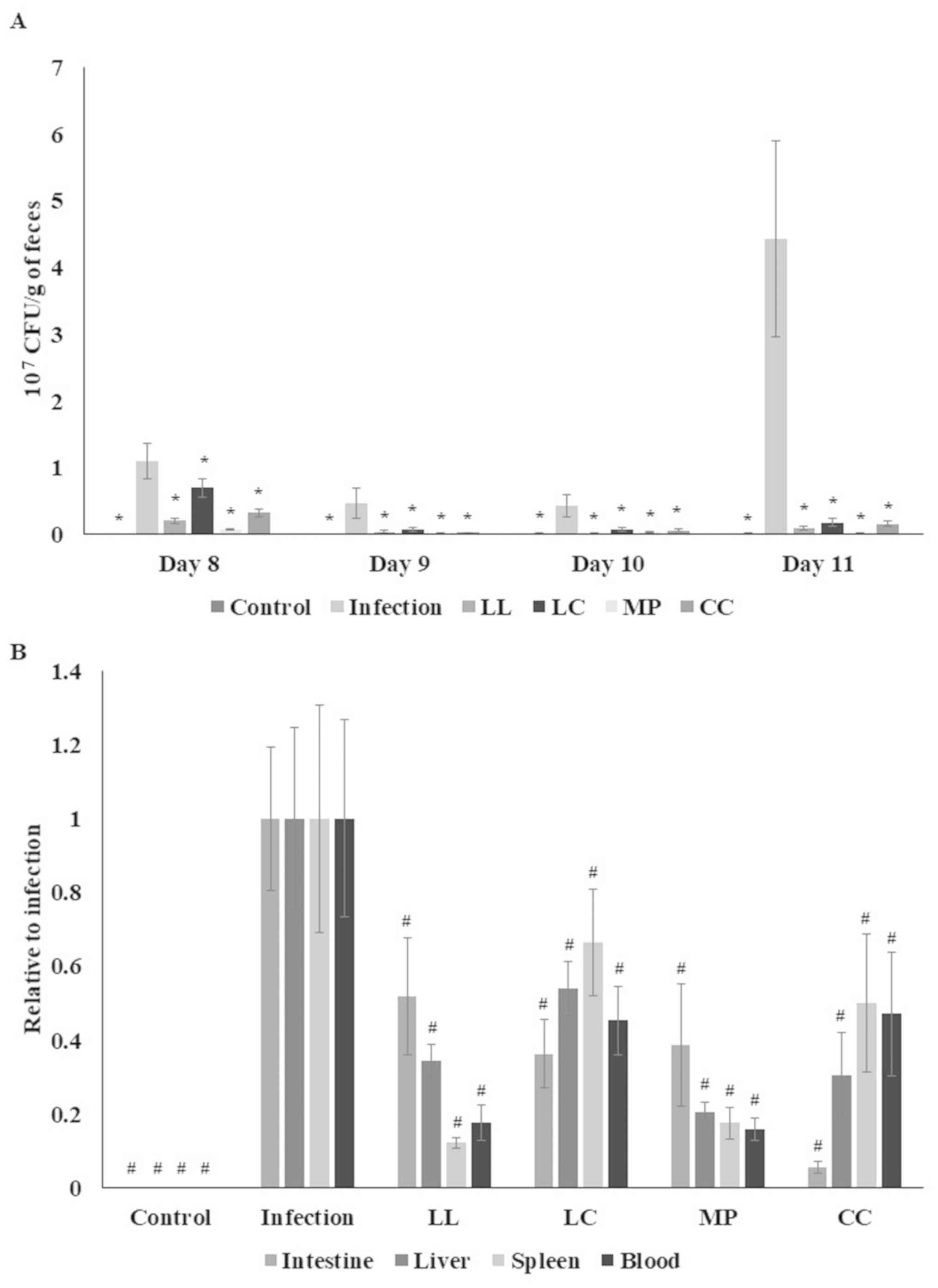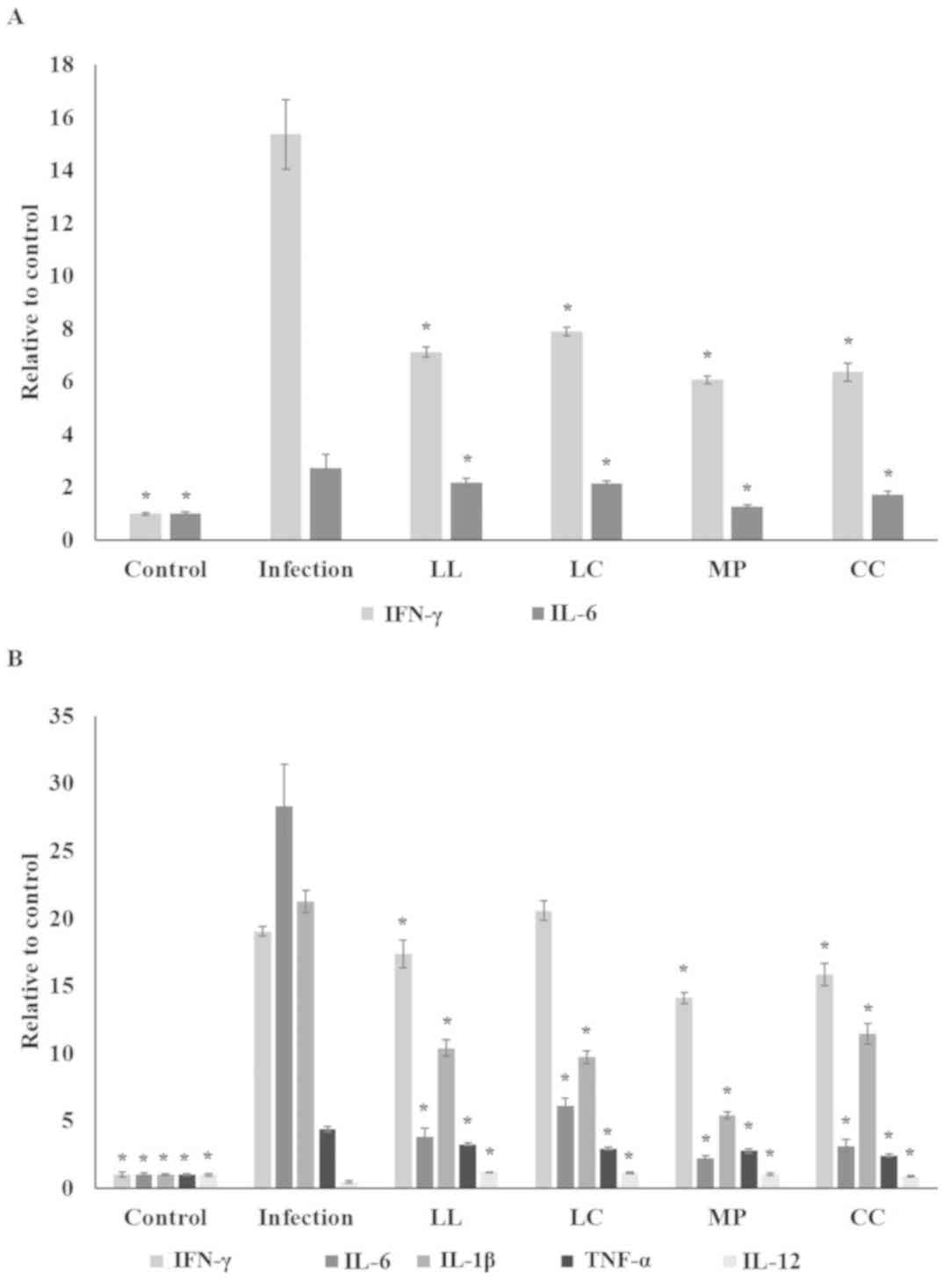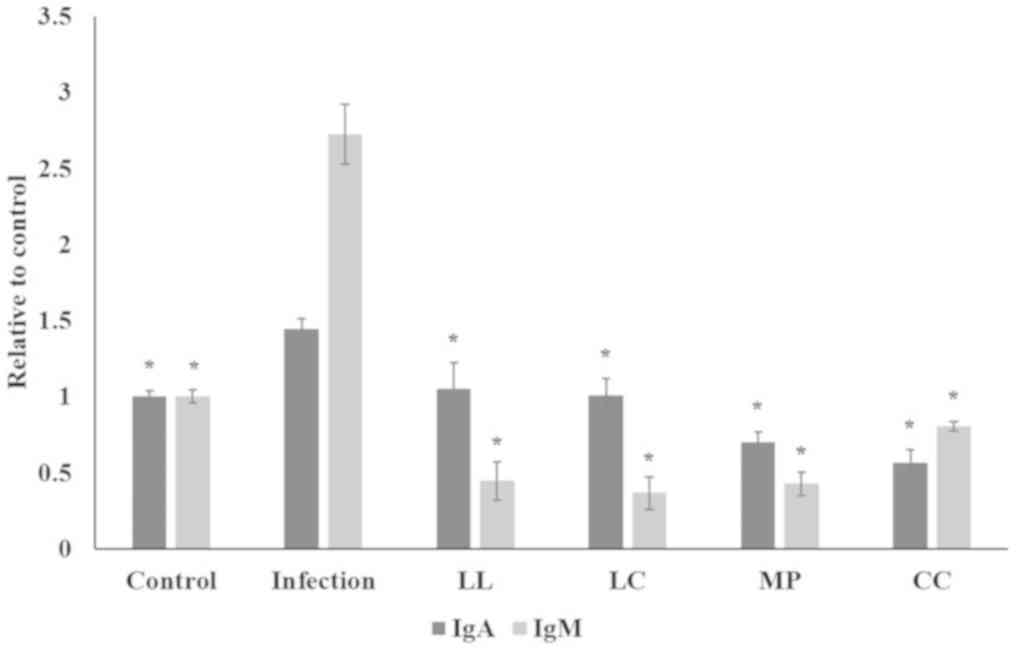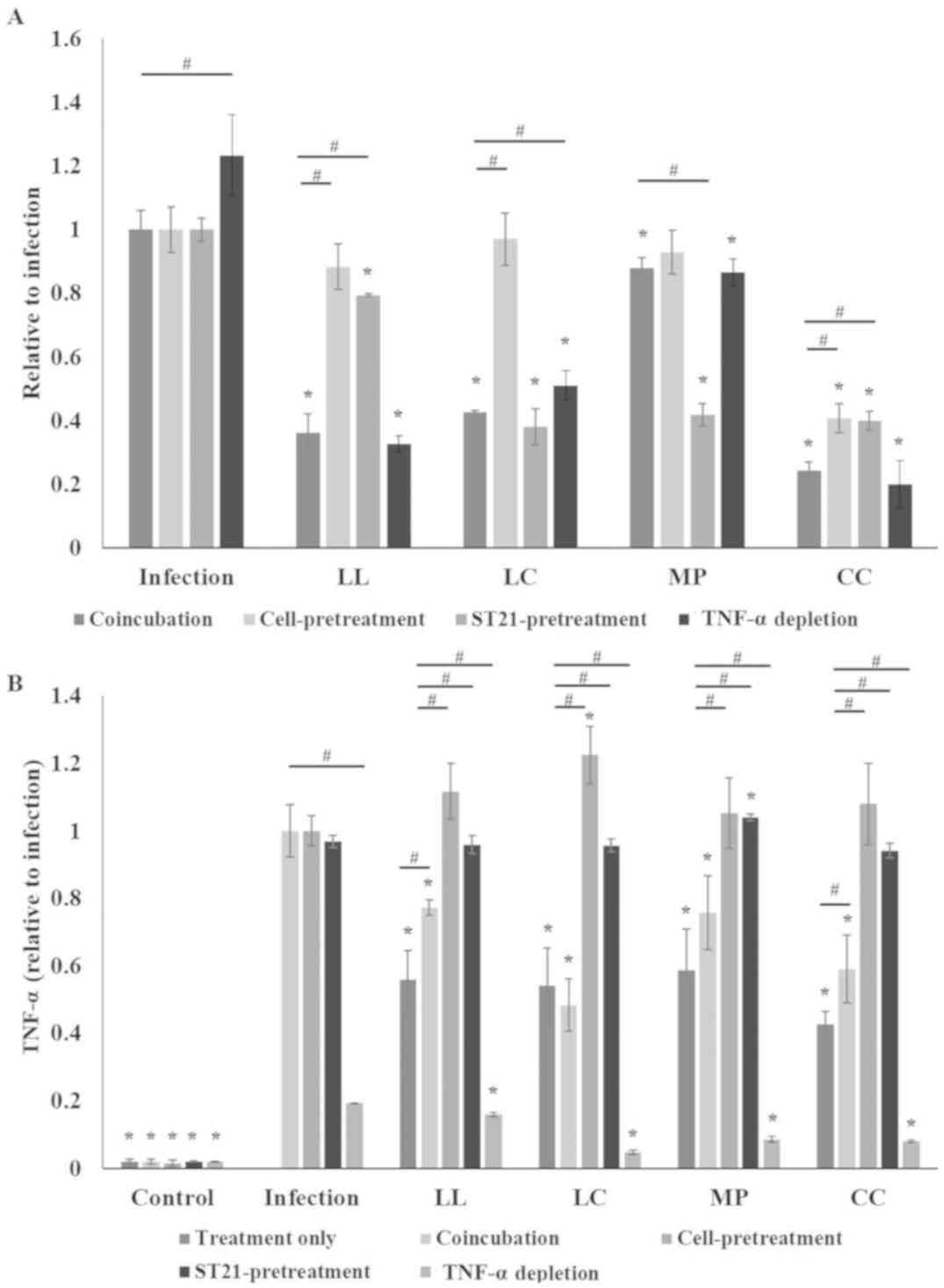|
1
|
Heithoff DM, Shimp WR, Lau PW, Badie G,
Enioutina EY, Daynes RA, Byrne BA, House JK and Mahan MJ: Human
Salmonella clinical isolates distinct from those of animal
origin. Appl Environ Microbiol. 74:1757–1766. 2008. View Article : Google Scholar : PubMed/NCBI
|
|
2
|
LaRock DL, Chaudhary A and Miller SI:
Salmonellae interactions with host processes. Nat Rev
Microbiol. 13:191–205. 2015. View Article : Google Scholar : PubMed/NCBI
|
|
3
|
Keestra-Gounder AM, Tsolis RM and Baumler
AJ: Now you see me, now you don't: The interaction of
Salmonella with innate immune receptors. Nat Rev Microbiol.
13:206–216. 2015. View Article : Google Scholar : PubMed/NCBI
|
|
4
|
Beal RK, Wigley P, Powers C, Barrow PA and
Smith AL: Cross-reactive cellular and humoral immune responses to
Salmonella enterica serovars Typhimurium and Enteritidis are
associated with protection to heterologous re-challenge. Vet
Immunol Immunopathol. 114:84–93. 2006. View Article : Google Scholar : PubMed/NCBI
|
|
5
|
Lalmanach AC and Lantier F: Host cytokine
response and resistance to Salmonella infection. Microbes
Infect. 1:719–726. 1999. View Article : Google Scholar : PubMed/NCBI
|
|
6
|
Krzyzanowska J, Janda B, Pecio L, Stochmal
A, Oleszek W, Czubacka A, Przybys M and Doroszewska T:
Determination of polyphenols in Mentha longifolia and M.
piperita field-grown and in vitro plant samples using
UPLC-TQ-MS. J AOAC Int. 94:43–50. 2011.PubMed/NCBI
|
|
7
|
Xia EQ, Yu YY, Xu XR, Deng GF, Guo YJ and
Li HB: Ultrasound-assisted extraction of oleanolic acid and ursolic
acid from Ligustrum lucidum Ait. Ultrason Sonochem.
19:772–776. 2012. View Article : Google Scholar : PubMed/NCBI
|
|
8
|
Jurikova T, Mlcek J, Skrovankova S, Balla
S, Sochor J, Baron M and Sumczynski D: Black crowberry (Empetrum
nigrum L.) flavonoids and their health promoting activity.
Molecules. 21:E16852016. View Article : Google Scholar : PubMed/NCBI
|
|
9
|
An HJ, Jeong HJ, Um JY, Park YJ, Park RK,
Kim EC, Na HJ, Shin TY, Kim HM and Hong SH: Fructus Ligustrum
lucidi inhibits inflammatory mediator release through
inhibition of nuclear factor-kappaB in mouse peritoneal
macrophages. J Pharm Pharmacol. 59:1279–1285. 2007. View Article : Google Scholar : PubMed/NCBI
|
|
10
|
Kozłowska M, Laudy AE, Przybył J, Ziarno M
and Majewska E: Chemical composition and antibacterial activity of
some medicinal plants from lamiaceae family. Acta Pol Pharm.
72:757–767. 2015.PubMed/NCBI
|
|
11
|
Akdemir Evrendilek G: Empirical prediction
and validation of antibacterial inhibitory effects of various plant
essential oils on common pathogenic bacteria. Int J Food Microbiol.
202:35–41. 2015. View Article : Google Scholar : PubMed/NCBI
|
|
12
|
Alzoreky NS and Nakahara K: Antibacterial
activity of extracts from some edible plants commonly consumed in
Asia. Int J Food Microbiol. 80:223–230. 2003. View Article : Google Scholar : PubMed/NCBI
|
|
13
|
Chang CH, Yu B, Su CH, Chen DS, Hou YC,
Chen YS and Hsu YM: Coptidis rhizome and Si Jun Zi Tang can prevent
Salmonella enterica serovar Typhimurium infection in mice.
PLoS One. 9:e1053622014. View Article : Google Scholar : PubMed/NCBI
|
|
14
|
Sreelatha S and Padma PR: Antioxidant
activity and total phenolic content of Moringa oleifera
leaves in two stages of maturity. Plant Foods Hum Nutr. 64:303–311.
2009. View Article : Google Scholar : PubMed/NCBI
|
|
15
|
Yin MC, Chang CH, Su CH, Yu B and Hsu YM:
Pteris multifida, Cortex phellodendri, and probiotics
attenuated inflammatory status and immunity in mice with a
Salmonella enterica serovar Typhimurium infection. Biosci
Biotechnol Biochem. 1–12. 2018.PubMed/NCBI
|
|
16
|
Doyle MP and Erickson MC: Reducing the
carriage of foodborne pathogens in livestock and poultry. Poult
Sci. 85:960–973. 2006. View Article : Google Scholar : PubMed/NCBI
|
|
17
|
Kuda T, Kosaka M, Hirano S, Kawahara M,
Sato M, Kaneshima T, Nishizawa M, Takahashi H and Kimura B: Effect
of sodium-alginate and laminaran on Salmonella Typhimurium
infection in human enterocyte-like HT-29-Luc cells and BALB/c mice.
Carbohydr Polym. 125:113–119. 2015. View Article : Google Scholar : PubMed/NCBI
|
|
18
|
Drago-Serrano ME, Rivera-Aguilar V,
Reséndiz-Albor AA and Campos-Rodríguez R: Lactoferrin increases
both resistance to Salmonella typhimurium infection and the
production of antibodies in mice. Immunol Lett. 134:35–46. 2010.
View Article : Google Scholar : PubMed/NCBI
|
|
19
|
Wijburg OL, Uren TK, Simpfendorfer K,
Johansen FE, Brandtzaeg P and Strugnell RA: Innate secretory
antibodies protect against natural Salmonella typhimurium
infection. J Exp Med. 203:21–26. 2006. View Article : Google Scholar : PubMed/NCBI
|
|
20
|
Senthilkumar PK and Reetha D: Isolation
and identification of antibacterial compound from the leaves of
Cassia auriculata. Eur Rev Med Pharmacol Sci. 15:1034–1038.
2011.PubMed/NCBI
|
|
21
|
Senthil S, Sridevi M and Pugalendi KV:
Cardioprotective effect of oleanolic acid on isoproterenol-induced
myocardial ischemia in rats. Toxicol Pathol. 35:418–423. 2007.
View Article : Google Scholar : PubMed/NCBI
|
|
22
|
Dorman HJ, Koşar M, Başer KH and Hiltunen
R: Phenolic profile and antioxidant evaluation of Mentha ×
piperita L. (peppermint) extracts. Nat Prod Commun. 4:535–542.
2009.PubMed/NCBI
|
|
23
|
Sandhiutami NM, Moordiani M, Laksmitawati
DR, Fauziah N, Maesaroh M and Widowati W: In vitro assesment of
anti-inflammatory activities of coumarin and Indonesian cassia
extract in RAW264.7 murine macrophage cell line. Iran J Basic Med
Sci. 20:99–106. 2017.PubMed/NCBI
|
|
24
|
Wang J, Zhang Y, Zhang Y, Cui Y, Liu J and
Zhang B: Protective effect of Lysimachia christinae against
acute alcohol-induced liver injury in mice. Biosci Trends. 6:89–97.
2012.PubMed/NCBI
|
|
25
|
Chang HD, Helbig C, Tykocinski L, Kreher
S, Koeck J, Niesner U and Radbruch A: Expression of IL-10 in Th
memory lymphocytes is conditional on IL-12 or IL-4, unless the
IL-10 gene is imprinted by GATA-3. Eur J Immunol. 37:807–817. 2007.
View Article : Google Scholar : PubMed/NCBI
|
|
26
|
Maghraby A and Bahgat M: Immunostimulatory
effect of coumarin derivatives before and after infection of mice
with the parasite Schistosoma mansoni.
Arzneimittelforschung. 54:545–550. 2004.PubMed/NCBI
|
|
27
|
Dejani NN, Souza LC, Oliveira SR, Neris
DM, Rodolpho JM, Correia RO, Rodrigues V, Sacramento LV, Faccioli
LH, Afonso A and Anibal FF: Immunological and parasitological
parameters in Schistosoma mansoni-infected mice treated with
crude extract from the leaves of Mentha × piperita L.
Immunobiology. 219:627–632. 2014. View Article : Google Scholar : PubMed/NCBI
|
|
28
|
Lake BG, Evans JG, Chapuis F, Walters DG
and Price RJ: Studies on the disposition, metabolism and
hepatotoxicity of coumarin in the rat and Syrian hamster. Food Chem
Toxicol. 40:809–823. 2002. View Article : Google Scholar : PubMed/NCBI
|















